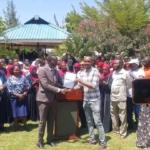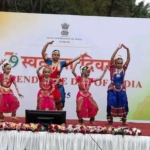Anchorage, Alaska| In a momentous display of diplomatic maneuvering amid escalating global tensions, Russian President Vladimir Putin and U.S. President Donald Trump convened for a high-stakes summit in the rugged landscapes of Alaska, marking a pivotal chapter in international relations.
Held at Joint Base Elmendorf-Richardson in Anchorage, the talks—dubbed “historic” by the White House—aim to forge a breakthrough in the protracted Ukraine conflict while exploring avenues for enhanced bilateral ties.
As the world watches with bated breath, this unprecedented gathering of two powerhouse leaders underscores the delicate balance of power, peace negotiations, and economic collaboration in an era of uncertainty.
The summit officially commenced on Friday, August 15, 2025, following the near-simultaneous arrivals of Putin and Trump on the tarmac, where they exchanged warm greetings that contrasted sharply with recent U.S.-Ukraine interactions.
This meeting comes at a critical juncture, with the Ukraine war showing no signs of abating and global security hanging in the balance.
Moscow has emphasized its agenda, which extends beyond Ukraine to encompass “global peace and security” and the “further development of bilateral cooperation” in economy and trade.
Trump, ever the dealmaker, has framed the encounter as a “feel-out meeting,” candidly assessing a 25% chance of outright failure while floating innovative ideas like a potential land-swap deal between Russia and Ukraine to resolve territorial disputes.
A Dramatic Arrival and Symbolism on the Tarmac
The day’s events unfolded with cinematic flair, beginning around 19:12 GMT when Putin and Trump stepped off their respective aircraft onto the Alaskan tarmac almost in unison.
The two leaders, representing nations long entangled in Cold War echoes and modern geopolitical rivalries, shared a firm handshake, shoulder pats, and genuine smiles—gestures that spoke volumes about the potential for rapport.
They posed for a joint photo, capturing a moment of tentative optimism, before Putin slid into Trump’s presidential limousine, waving from the window as they drove off together.
Notably, no interpreters were present during this initial exchange, a rarity for superpower summits, owing to Putin’s proficient English skills. This intimate setup in the same vehicle symbolized a departure from protocol, hinting at Trump’s signature style of personal diplomacy.
As they departed the airfield, the skies above roared with American military might: footage captured a B-2 Spirit stealth bomber, flanked by four F-22 Raptor fighters, soaring overhead in a dramatic flyover.
This display, occurring around 20:03 GMT, served as both a photo-op backdrop and a subtle reminder of U.S. strategic capabilities amid the sensitive negotiations.
Inside the Delegations: Key Players Shaping the Dialogue
The summit’s gravity is amplified by the heavyweight delegations accompanying each leader. Russia’s team, led by Putin, features a blend of diplomatic, military, and economic expertise.
Foreign Minister Sergey Lavrov brings decades of experience in navigating East-West relations, while Defense Minister Andrey Belousov offers insights into security dynamics.
Finance Minister Anton Siluanov and Kremlin aide Yury Ushakov add fiscal and advisory depth, and presidential economic envoy Kirill Dmitriev—pivotal in prior Ukraine settlement efforts—rounds out the group, signaling Moscow’s intent to push for tangible outcomes.
On the American side, Trump is flanked by a roster of trusted advisors and officials aligned with his “America First” vision.
Secretary of State Marco Rubio, known for his hawkish stance on foreign policy, joins Treasury Secretary Scott Bessent and Commerce Secretary Howard Lutnick to address economic angles.
Special Envoy Steve Witkoff, a real estate magnate with ties to Trump, and CIA Director John Ratcliffe, a former intelligence chief, complete the lineup, ensuring a multifaceted approach to intelligence, trade, and negotiation strategies.
Moscow entered the talks with a “clear and well-defined” position, backed by robust arguments, as stated by Russian officials.
This preparedness contrasts with Trump’s pragmatic outlook, emphasizing exploratory discussions that could pivot toward creative solutions like territorial exchanges—a concept that has sparked both intrigue and controversy among analysts.
Timeline of Unfolding Events: From Arrival to Opening Salvos
The summit’s progression was meticulously documented, offering a real-time glimpse into this diplomatic theater:
- 19:12 GMT: Putin and Trump’s planes touched down in sync, setting the stage for their immediate greeting and photo session, a visual emblem of potential thaw in relations.
- 19:19 GMT: The leaders’ handshake evolved into a friendly exchange, culminating in their shared ride to the base—a move that raised eyebrows for its informality.
- 19:31 GMT: Initial footage from the talks surfaced, showing American journalists firing questions at Putin as the meeting kicked off, highlighting the media frenzy surrounding the event.
- 19:45 GMT: Official negotiations began, with RT correspondent Egor Piskunov capturing the opening moments before media were escorted out, preserving an air of secrecy.
- 20:03 GMT: The B-2 bomber flyover added a layer of spectacle, blending military symbolism with the pursuit of peace.
- 20:09 GMT: Reports emphasized the absence of interpreters and the unusual limousine sharing, underscoring the personal chemistry between the leaders.
- 20:17 GMT: Heavy security blanketed the venue, including snipers, armored vehicles, and hundreds of personnel, reflecting the high-risk nature of the summit.
- 20:18 GMT: The White House released a joint photo of the smiling duo, captioned “Pursuing Peace,” amplifying the narrative of hope.
- 21:12 GMT: Media outlets like NBC drew parallels between Trump’s warm reception of Putin and his February Oval Office meeting with Ukrainian President Vladimir Zelensky, which ended acrimoniously with criticisms of Zelensky’s ingratitude from Trump and Vice President J.D. Vance.
- 21:15 GMT: The White House amplified the event’s significance on social media, posting a red-carpet photo and labeling the summit “historic,” further fueling global discourse.
Broader Implications: Ukraine Settlement, Economic Ties, and Global Repercussions
At the heart of the discussions lies the Ukraine conflict, a flashpoint that has claimed countless lives, disrupted global energy markets, and strained international alliances since its escalation in 2022.
Trump’s suggestion of a land-swap—potentially involving territorial concessions—represents a bold, if divisive, proposal that could redraw maps but risks alienating Kyiv and NATO allies.
Moscow’s broader agenda, including economic and trade cooperation, hints at opportunities for de-escalation, such as easing sanctions or fostering joint ventures in energy and technology.
Experts view this summit as a litmus test for Trump’s second-term foreign policy, which prioritizes deal-making over traditional alliances.
The 25% failure risk acknowledged by Trump injects realism, acknowledging deep-seated mistrust rooted in issues like election interference allegations and differing views on NATO.
Yet, the “historic” framing by the White House suggests optimism, positioning the talks as a step toward stabilizing global security.
Security measures at the base were ironclad, with layered defenses ensuring no disruptions—a prudent move given the summit’s polarizing nature. Protests and counter-demonstrations simmered in Anchorage, reflecting divided public opinion on engaging with Russia.
As the talks continue into August 16 and beyond, the world awaits outcomes that could reshape geopolitics.
Will this Alaskan rendezvous yield a Ukraine peace accord, or merely a fleeting photo-op? Only time—and the leaders’ negotiations—will tell. For more updates on the Putin-Trump summit, Ukraine peace talks, and U.S.-Russia relations, stay tuned.
Share This Post





